The pre-assembled USA-1 comes in a predictably gigantic box. The
features are highlighted in detail on the bottom of the box as shown.
Here's a bonus I wasn't expecting. In additional to the RTR
running manual, this model came with a full build manual (left).
This allowed me to do what I love to do most with RTR's: tear it down to
the bones and build it from scratch.
These images show the results of my tear down. You may note that
I've only disassembled one of the axles to see how it goes
together. The other is pretty much the same so I left it
alone. I also did not open up the differentials or shocks since I
didn't want to refill them. On the right you can see the piles of
hardware along with the large assembly tools that came with the kit. It's amazing how much steel there is in this model.

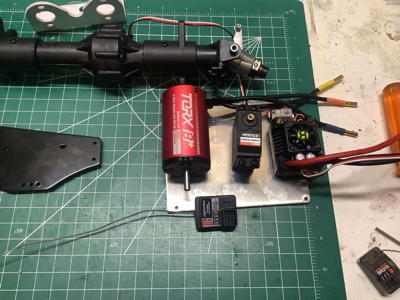
The suspension links are plastic while the panhard links are aluminum
. The steel driveshafts are shown to the right. On the
far right you can see the electronics package. The radio system is
completely adequate, but I replaced the receiver with a Spektrum so I
use my normal radio. The steering servo has a paltry 125 oz-in of
torque which is pretty sad for a model of this size, but it seems to
work OK. It does have metal gears and has proven durable so
far. As far as I can tell, the clumsily named "Torx" motor and
"Braniz" ESC are both rebranded Hobbywing items. The motor is an
EZRun 4268 2300kV model which is actually slightly different than the
one currently offered by Hobbywing (2600kV), but otherwise appears
identical. The ESC appears to be an EZrun Max 10 SCT. Note
that this is a 10th scale ESC paired with an 8th scale motor, but it is
rated for motors up to 3000kV at 4s, so it should be fine.

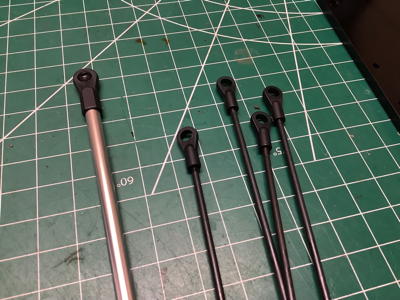
Here are a couple of oddities of part sizing. The shaft on the
pinion for the differentials is a massive 8mm in diameter and made of
steel. Great! But the drive shaft which feeds it (and
carries exactly the same torque) is only 5mm. That's a 2.5x
difference in strength for mating parts. Why? On the right
you can see a similar issue on the rods. The panhard bars are 6mm
in diameter while the steering links are 3mm. 3mm is really small
for a model with massive tires like these. They seem like the
weakest part of the design. With that being said, the steering
servo hardly carries any torque anyway.
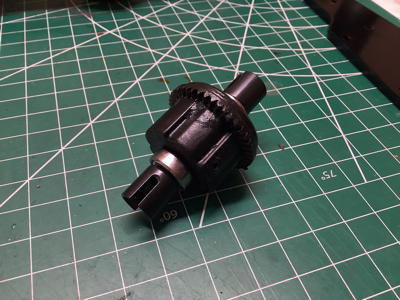

I didn't open up the differential but according to the manual it uses 4
steel spider gears and 3000wt silicone oil. The drive cups are
supporting by massive 8x15mm ball bearings so they should be plenty
strong. The picture on the right shows the parts needed to support
the differential, ring, and pinion into the axle housing. The
axle diameter is much larger than the parts inside it, so it is mostly
empty space. Still, that diameter gives it a lot of bending
stiffness. The real USA-1 used axles from a 5-ton, so I'm OK with it.
On the left you can see the central part of the axle housing buttoned
up. On the right I've added the extension tubes which form the
suspension mounts. Note that the differential is off center.
The steering knuckles are cast aluminum and use dual 8x16mm
bearings. The hexes are 17mm. An exploded view is shown on
the left. The right hand image shows the completed assemblies
which you can see are labelled L and R.
Now the steering supports can be installed as shown on the left.
The axle itself is a dogbone style. I would have preferred
universals here. The steering knuckles are supported within the
supports using a set of steel flanged bushings.
Now the front and rear axles are complete. Note that both support
steering, though only the front axle is equipped for it out of the
box. The rear axle uses a set of short links to lock the steering
angle. The front axle has a bell crank mounted the housing which
means two steering links are needed. Note that the rear drive
shaft is fixed length while the front uses a sliding joint.
Why? Perhaps because this model does wheelies so the front axle
sees full extension and compression regularly and needs more
travel. Just a guess. With the axles oriented toward
each other as shown on the right, you can see that both differentials are
offset toward the right of the vehicle.
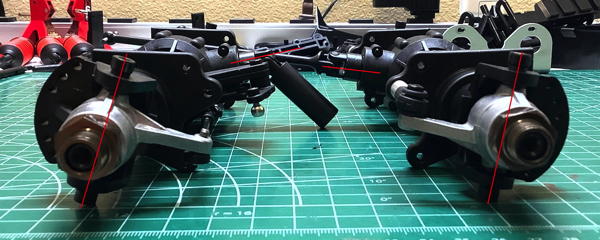
It may appear at first that the front and rear axles are identical, but
they are not. If they were the same, the huge caster angle of the
front axle would be mirrored on the back which would make the rear
wheels almost impossible to keep stable (if connected to steering) like
the Clodbuster. Caster angle tends to keep the wheels facing
forward when rolling, but if it is reversed the wheels will always want
to turn. Instead, the rear axle is set up so there will be no
caster at all once the axle is installed (the kingpin will be
vertical). You can also see that the angle at which the drive
shaft departs the differential is different between front and rear.

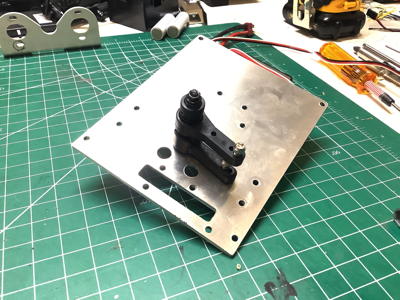
This model has a steering system like nothing I've ever seen before,
although it shares certain similarities with the Clodbuster. The
single steering servo is centrally mounted and drives an input
bellcrank. Between the input and output cranks is a servo
saver. To enable rear steering, you just add another ball joint to
the output crank and install steering rods to the rear. Since
front and rear use the same crank, there is no way to turn the rear
steer on and off if you decide to go with this option.
I've never seen a chain drive monster truck before. I haven't run
the numbers, but it certainly seems like this chain would be the weak
point in the drivetrain. The drive sprocket has 11 teeth while the
follower has 26 so there is a 2.36:1 reduction here. The picture
on the right shows the follower sprocket attached to the drive shafts.
Here the chain assembly is attached to the central chassis brace and
passed through a slot. This brace also serves as the electronics
tray. On the right I've added the upper sprocket which is attached
to a shaft supported by a pair of pillow blocks. You'll also see
that there are two motor mounts which means this model can support twin
motors. Only a madman would ever do that with a brushless system
(like my TXT-2), but I could see using a pair of brushed motors.
This is a very odd slipper clutch because it is not adjustable.
You tighten the nut down firmly. It works because the metal
bushing (lower right) is slightly thicker than the spur gear it fits
into which means you are clamping across the bushing, not across the
friction surfaces. This results in a fixed amount of clamping
force based completely on geometry.
The 1.0 mod steel pinion gear has 16 teeth while the plastic spur has 42
so that's a 2.63:1 reduction. Combined with the chain reduction
of 2.36:1 and the ring/pinion reduction of 3.31:1, that's an overall
reduction of 20.5:1.
This is a Twin Vertical Plate chassis like the old HPI Savage monster
trucks. These aluminum plates ensure that there is going to be
essentially no longitudinal bending. The twin battery boxes attach
directly to the plates as shown. These battery boxes have
adjustable covers that allow the use of very thick batteries if desired.
Here the central transmission assembly has been used to join the two
chassis plates. The method of attaching the transmission is, in my
opinion, pretty weak. They use giant steel standoffs, but with
only one fastener per part.
These two cross members support both the steering servo and the massive
radio box. You may wonder at the need for such a large box, but
keep in mind that this model is also available in nitro in which case
this box would also contain a receiver battery box. Those big
steel ball joints you see sticking out the sides of the chassis plates
are for the shocks.
Here I've completed the installation of the electronics and closed up
the radio box. At this point I can install batteries and make sure
everything works.
The front bumper is installed directly to a chassis cross member making
it very strong. You can also see that I've installed the front
body posts at this point.
There is no structural rear bumper, instead the wheelie bar serves and
both the rear cross member and bumper. The rear shock mounts are
also extended behind the chassis plates with those wheelie bar
brackets. Though it is not evident from this picture, there is a
big problem with the wheelie bar. That nice big wheel on ball
bearing cannot actually turn because the body rubs on it.
The large bore oil shocks are very nice, but the angle at which they are
installed is very strange. They are tipped back a lot and also
considerably inboard. I suppose this is just because the axles are
so wide, but it makes for an unusual stance. They seem to soak up
the bumps though. It is very strange for a 4-link suspension to
also have a panhard bar, but the links are not triangulated so the
lateral link is required.
The triple carburetors and supercharger are not part of the body, they
actually attach to the body posts and poke through a hole in the
body. Why? It seems like I have asked that question quite a
few times with this model.
The tires are truly enormous as you would expect from a scale monster
truck. They are roughly equivalent in size to what you would find
on the Clodbuster. The installation of the wheels and tires
completes the chassis.
After completing the build I had these 4 screws left. That seems
bad. It doesn't mean anything is missing though. As I built I
made sure I installed all the right sizes per the instructions and that
forced me to use a few fasteners from my own stock since some were
missing. That implies that these screws were installed in the RTR
but do not match the manual.